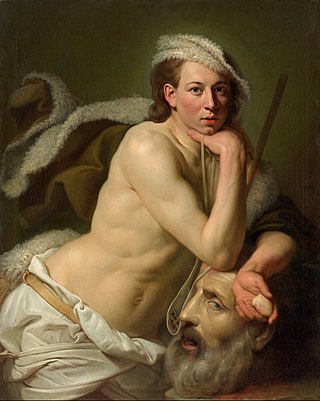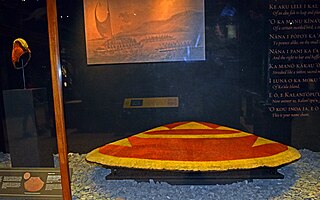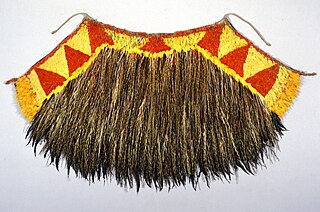Death of Cook is the name of several paintings depicting the 1779 death of the first European visitor to the Hawaiian Islands, Captain James Cook at Kealakekua Bay. Most of these paintings seem to go back to an original by John Cleveley the Younger, painted in 1784, although other versions, like that of John Webber, stood model for later copies too. Such artworks were reproduced in paint and engraving over the course of modern world history. The much more famous reproductions, like the one at the Honolulu Museum of Art, often depicted Cook as a peacemaker trying to stop the fighting between his sailors and the native Hawaiians that they had challenged in combat.

Johan Joseph Zoffany was a German neoclassical painter who was active mainly in England, Italy and India. His works appear in many prominent British collections, including the National Gallery, the Tate Gallery and the Royal Collection, as well as institutions in continental Europe, India, the United States and Australia. His name is sometimes spelled Zoffani or Zauffelij.

The Hawaiian archipelago consists of 137 islands in the Pacific Ocean that are far from any other land. Polynesians arrived there one to two thousand years ago, and in 1778 Captain James Cook and his crew became the first Europeans to visit Hawaii. The art created in these islands may be divided into art existing prior to Cook’s arrival; art produced by recently arrived westerners; and art produced by Hawaiians incorporating western materials and ideas. Public collections of Hawaiian art may be found at the Honolulu Museum of Art, the Bishop Museum (Honolulu), the Hawaii State Art Museum and the University of Göttingen in Germany.

The Tribuna of the Uffizi (1772–1778) by Johan Zoffany is a painting of the north-east section of the Tribuna room in the Uffizi in Florence, Italy. The painting is part of the United Kingdom's Royal Collection.

Kalaniʻōpuʻu-a-Kaiamamao was the aliʻi nui of the island of Hawaiʻi. He was called Terreeoboo, King of Owhyhee by James Cook and other Europeans. His name has also been written as Kaleiopuu.

The ʻAhu ʻula, and the mahiole were symbols of the highest rank of the chiefly aliʻi class of ancient Hawaii. The feathered cloaks and capes provided physical protection, and were believed to provide spiritual protection for their wearers. There are over 160 examples of this traditional clothing in museums around the world. At least six of these cloaks were collected during the voyages of Captain Cook. These cloaks are made from a woven netting decorated with bird feathers and are examples of fine featherwork techniques. One of these cloaks was included in a painting of Cook's death by Johann Zoffany.

Thomas Patch was an English painter, printmaker in etching, physiognomist and art historian. He made a living from painting views of Florence and Tivoli and appears to have sold a number of painted caricature groups to members of the Anglo-Florentine community and to young British men on the Grand Tour. The largest collection of his paintings and prints is in the Lewis Walpole Library in Farmington, Connecticut.

Colonel Mordaunt's Cock Match, sometimes called Colonel Mordaunt's Cock Fight, is a painting by Johann Zoffany. The painting records British colonial life in the Indian court of Asaf-Ud-Dowlah. The painting is part of the Tate Gallery collection. The painting was completed in February 1788, four years after the event it records. A recent cleaning has revealed the original colours and made more apparent what appears to be an erection visible on the Nawab of Oudh, the central figure.

George Nassau Clavering-Cowper, 3rd Earl Cowper was an English peer who went on the Grand Tour as a young man, but actually emigrated. Despite becoming a member of parliament and later inheriting lands and the title of Earl Cowper in England, he remained in Italy. He amassed a valuable art collection and became a Prince of the Holy Roman Empire. He was a patron of the arts and science.

Other Hickman Windsor, 5th Earl of Plymouth FRS, styled Lord Windsor until 1771, was an English nobleman.

Hawaiian feather helmets, known as mahiole in the Hawaiian language, were worn with feather cloaks. These were symbols of the highest rank reserved for the men of the aliʻi, the chiefly class of Hawaii. There are examples of this traditional headgear in museums around the world. At least sixteen of these helmets were collected during the voyages of Captain Cook. These helmets are made from a woven frame structure decorated with bird feathers and are examples of fine featherwork techniques. One of these helmets was included in a painting of Cook's death by Johann Zoffany.

The Australian Museum's Cook Collection was acquired in 1894 when it was transferred from the Government of New South Wales. At that time it consisted of 115 artifacts collected on Captain James Cook's three voyages of discovery Throughout the Pacific Ocean, during the period 1768–1780, along with documents and memorabilia related to these voyages. Many of the ethnographic artifacts were collected at a time of first contact between Pacific Peoples and Europeans. In 1935 most of the documents and memorabilia were transferred to the Mitchell Library in the State Library of New South Wales. The provenance of the collection shows that the objects remained in the hands of Captain James Cook's widow, Mrs Elizabeth Cook and her descendants until 1886. In this year Mr John Mackrell, the great nephew of Isaac Smith, Elizabeth Cook's cousin, organized the display of this collection at the request of the NSW Government at the Colonial and Indian Exhibition in London. In 1887 the London-based Agent-General for the New South Wales Government, Saul Samuel, bought John Mackrell's items and also acquired those items belonging to the other relatives Reverend Canon Frederick Bennett, Mrs Thomas Langton, H.M.C.Alexander and Mr William Adams. The collection remained with the Colonial Secretary of NSW until 1894, when it was transferred to the Australian Museum.
Kānekapōlei was a Native Hawaiian aliʻi wahine (queen) and wife of Kalaniʻōpuʻu, aliʻi nui of the Island of Hawaii and aunt of Kamehameha I, who were all present at Captain James Cook's death. She called attention to the kidnapping of her husband by Cook and his men, attracting his royal attendants to the beach, answering her calls for help.

The Kamehameha I statue is an outdoor sculpture by American artist Thomas Ridgeway Gould, cast in 1880 and installed in 1883. It stands in front of the old country courthouse in the town of Kapaʻau, located in North Kohala on the Island of Hawaiʻi. Made of cast brass and painted with lifelike colors, it depicts Kamehameha I, and represents an important cultural and spiritual object for the local community.

Felton Hervey was an aristocratic English politician from Bury St Edmunds in Suffolk, and a member of the British royal household. He took his son and daughter on a grand tour of Italy where he met Johann Zoffany and Pope Clement XIV.

Charles Loraine Smith or Charles Loraine was a sportsman, artist and politician. He inherited his family seat in Enderby, Leicestershire while still a boy. He was a keen horseman and his paintings of animals are well regarded. He painted both parodies and more serious subjects. He served in the British parliament, was mentioned in a divorce case, met the pope and rose to be a High Sheriff of Leicestershire.

Kalaimanokahoʻowaha was an aliʻi high chief of the island of Hawaii who lived during the period of Captain James Cook's visit to the islands. He was the chief said to have struck the first blow to Cook when he attempted to kidnap Kalaniʻōpuʻu, the king of the island. He was called Kanaʻina nui as a birthright from his father, Keaweʻopala, first born son of Alapainui. After his father was killed by Kalaniʻōpuʻu, he would serve the new king as a kaukau aliʻi, a service class of Hawaiian nobility that his mother, Moana Wahine had descended from. This aliʻi service line would continue throughout the Kingdom of Hawaii.
The original rulers of the Hawaiian islands were a line of native Hawaiians who were independent monarchs of various subdivisions of the land and islands of Hawaii. Their genealogy is traced to Hānalaʻanui and others. The caste system of ancient Hawaiian society was established around 1200 AD and separated the people into 4 distinct ranks that were all below the supreme ruler of the island. The ali‘i nui would distribute the land to the lower ranking chiefs who would run the land and collect offerings and taxes. The ali‘i nui would also ultimately be responsible for the sacred kapu, a system of rules designed to control social order. The noho ali‘i were known for their brightly colored and intricately constructed battle regalia of feathered capes and helmets called a mahiole (helmet) and ʻahu ʻula.

On 14 February 1779, English explorer Captain James Cook attempted to kidnap Kalaniʻōpuʻu, the ruling chief of the island of Hawaii. The decision to hold him in exchange for a stolen longboat was the fatal error of Cook's final voyage, and led to his death at Kealakekua Bay.

Venus with a Satyr and Two Cupids or The Bacchante is a 1588-1590 oil on canvas painting by Annibale Carracci, now in the Uffizi in Florence. Its dating is based on its strong Venetian influence - the artist was briefly in the city at the end of the 1580s.

















